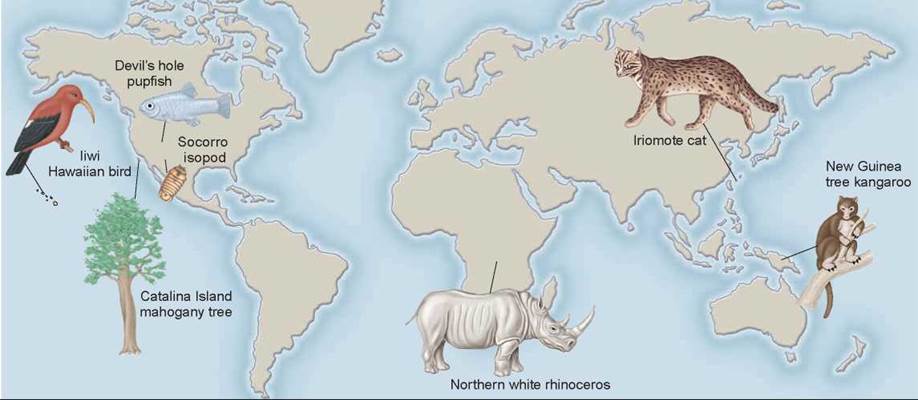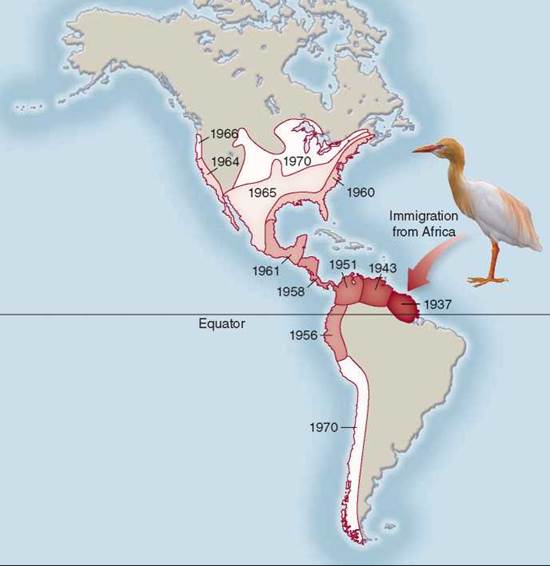THE LIVING WORLD
Unit Eight. The Living Environment
35. Populations and Communities
Organisms live as members of populations, groups of individuals that occur together at one place and time. Whether the population is a group of birds, insects, plants, or humans, ecologists can study several key elements of populations and learn more about them.
The term “population” can be defined narrowly or broadly. This flexibility allows us to speak in similar terms of the world’s human population, the population of protists in the gut of an individual termite, or the population of deer that inhabit a forest. Sometimes the boundaries defining a population are sharp, such as the edge of an isolated mountain lake for trout, and sometimes they are fuzzier, such as when individual deer readily move back and forth between two forests separated by a cornfield.
Five aspects of populations are particularly important: population range, which is the area throughout which a population occurs; population distribution, which is the pattern of spacing of individuals within that range; population size, which is the number of individuals a population contains; population density, which is how many individuals share an area; and population growth, which describes whether a population is growing or shrinking, and at what rate. We will consider each in turn.
Population Ranges
No population, not even one composed of humans, occurs in all habitats throughout the world. Most species, in fact, have relatively limited geographic ranges, and the range of some species is minuscule. The Devil’s Hole pupfish, for example, lives in a single hot water spring in southern Nevada, and the Socorro isopod is known from a single spring system in New Mexico. Figure 35.4 shows a collection of other species that are found in a single population in an isolated habitat. At the other extreme, some species are widely distributed. The common dolphin (Delphinus delphis), for example, is found throughout all of the world’s oceans.

Figure 35.4. Species that occur in only one place.
These species, and many others, are only found in a single population. All are endangered species, and should anything happen to their single habitat, the population, and the species, would go extinct.
Organisms must be adapted for the environment in which they occur. Polar bears are exquisitely adapted to survive the cold of the Arctic, but you won’t find them in the tropical rain forest. Certain prokaryotes can live in the near-boiling waters of Yellowstone’s geysers, but they do not occur in cooler streams nearby. Each population has its own requirements—temperature, humidity, certain types of food, and a host of other factors—that determine where it can live and reproduce and where it can’t. In addition, in places that are otherwise suitable, the presence of predators, competitors, or parasites may prevent a population from occupying an area, a topic we will take up later in this chapter.
Range Expansions and Contractions
Population ranges are not static; rather, they change through time. These changes occur for two reasons. In some cases, the environment changes. For example, as the glaciers retreated at the end of the last Ice Age, approximately 10,000 years ago, many North American plant and animal populations expanded northward. At the same time, as climates warmed, species experienced shifts in the elevation at which they could live. The temperatures at higher elevations are cooler than at lower elevations. For example, the range for trees that survive better in colder temperatures shifts farther up a mountain when temperatures increase in an area as shown in figure 35.5.

Figure 35.5. Altitudinal shifts in population ranges in the mountains of southwestern North America.
During the glacial period 15,000 years ago, conditions were cooler than they are now. As the climate has warmed, tree species that require colder temperatures have shifted their range upward in altitude so that they live in the climatic conditions to which they are adapted.
In addition, populations can expand their ranges when they are able to move from inhospitable habitats to suitable, previously unoccupied areas. For example, cattle egrets native to Africa appeared in northern South America some time in the late 1800s. These birds made the nearly 2,000-mile transatlantic crossing, perhaps aided by strong winds. Since then, they have steadily expanded their range and now can be found throughout most of the United States (figure 35.6).

Figure 35.6. Range expansion of the cattle egret.
The cattle egret—so-named because it follows cattle and other hoofed animals, catching any insects or small vertebrates that they disturb—first arrived in South America in the late 1800s.
Since the 1930s, the range expansion of this species has been well- documented, as it has moved westward and up into much of North America, as well as down the western side of the Andes to near the southern tip of South America.
Key Learning Outcome 35.2. A population is a group of individuals of the same species existing together in an area. Its range, the area a population occupies, changes over time.